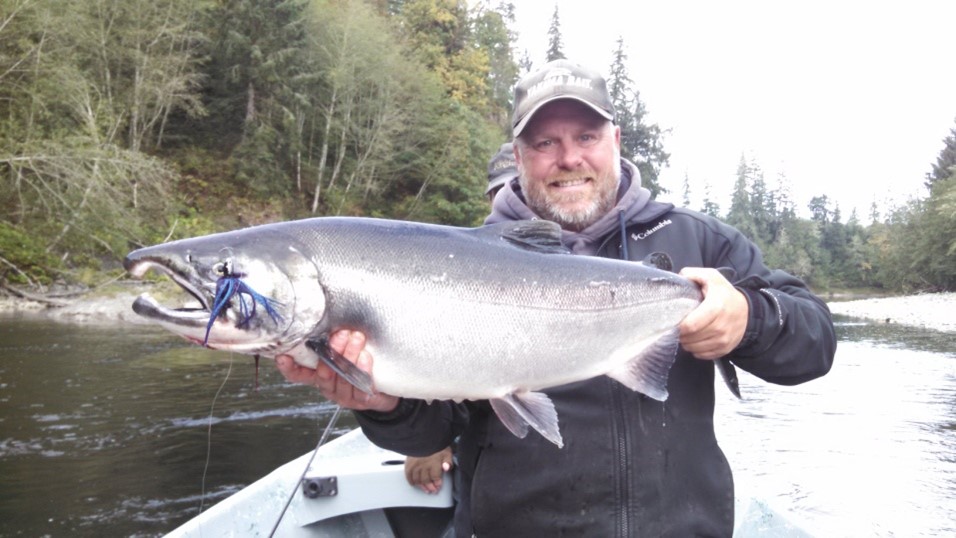By Buzz Ramsey
Twitching has captured the imagination of many anglers seeking coho salmon as they make their upstream journey toward the hatchery or natural habitat that produced them. Sure, traditional spinner, float, plug, and drift fishing methods work for coho but twitching, at least for those schooled in the proper use, can outperform other approaches much of the time.
In case you don’t know, Pacific Northwest fishing guide Bob Kratzer, 360-271-7197, is regarded as the father of twitching since he has been doing it effectively while guiding clients for nearly 30 years. Bob first caught coho thirty plus years ago incidentally while targeting trout with jigs in Alaska. You see, black or white colored marabou jigs can be very effective for river trout. This first coho catching experience sparked his interest in modifying the jigs he used for trout to perform even better for coho. Understanding that coho like hoochie squids, he first tried adding those to his trout jigs.
Bob kept experimenting with different dressing materials as related to the amount used and discovered that rabbit fur worked especially well because of its durability. He also discovered that adding a silicone tail and a few strands of reflective tinsel really upped his rate of success. In addition, via a lot of on-the-water experience, Bob discovered that a darter jig head would produce more fish than a round jig head design.
According to Bob, “When targeting coho with spinners the fish would refuse to strike them after a time but when presented with a jig twitched in the right way the fish would continue to bite all day long. It was incredible! Of course, using the right jig color is important. I recall one day catching 47 coho in a row while twitching after the bite had died with spinners, he shared.”

Twitching is the method of casting out and allowing your jig to fall freely to mid depth or near bottom, wherever the fish are holding, at which time you need to lift your rod tip up sharply with a get-their-attention snap of the rod tip. This means moving your rod tip up 12 to no-more-than 24 inches. It’s then that you quickly drop your rod tip while reeling 1/4 turn of the reel handle. This allows the jig to freefall straight down. The reeling is about keeping your line tight enough to keep your jig from sinking all the way to the bottom where it might hang up.
Since the fish will most often take the jig while it’s falling or at the bottom of the fall, it’s important to keep close tabs on what’s happening and to set the hook the instant you feel any hesitation or tightening up of your fishing line. A leaf catching on your jig hook might feel like the drag felt when a fish bites a falling jig. If you have experience jigging for bass, you will likely catch on to this fishing method fast.
Your rate of retrieve will likely vary depending on the water depth and influence of the river current has on your line and jig. For example, if you are hanging bottom while using a half-ounce jig, you might pick up your retrieve a little, say from a quarter to half turn of the reel handle, or switch to a 3/8-ounce jig. When fishing rivers, from boat or bank, Bob has his clients cast across the stream at a slight downriver angle and constantly twitch their jigs as they swing back across the river towards them. He instructs his clients to make repeated casts in areas where coho linger. Doing this helps keep the jig moving along and not catching bottom.
Likewise, if you are fishing deep water or in heavy current you might switch to a 5/8- or 3/4-ounce size jig. You should realize, however, that for most river applications it’s the 3/8- and 1/2-ounce jigs that are the most popular.
And while river coho are known to accumulate in slack water pools and hide around and among log structure and under overhanging trees or brush, you can catch them just about anywhere in rivers they navigate. And while Bob fishes every kind of water, he finds the most success for coho by targeting them in moving water; the same water you would fish when going after steelhead. What I found interesting is when Bob shared that he doesn’t keep pounding what many consider to be classic coho holding water. Sure, he makes five or six casts in these slow water areas but catches most of his coho in the same water steelhead use.
When it comes to what rod, reel and line works best for twitching, most anglers employ one piece, fast-taper spinning rods in the 7-1/2 to 7’10” range, rated for up to 20-pound test monofilament/30-pound braid, in combination with high quality spinning reels loaded with 30 pound test super braid. These short, somewhat stout rods facilitate strong hook sets and because they are not overly long, they reduce the leverage fatigue associated with the brisk lifting and then lowering of the rod tip while twitching.
According to the Northwest factory rep for Douglas, Tim Reilly, the company makes several rod actions for twitching in the LRS and XMatrix rod series. Tim’s favorite in the LRS series is the LRS 7104F rated for 8–17-pound test. The higher quality rod is the XMatrix and its models DXS 7104F and DXS 785F that are the most popular. Of course, some anglers like a casting rod for twitching and Tim’s favorite for this is the DXC 764MF rated for 12–20-pound mono/30-pound braid.
According to Tim, “One thing of note is that we are seeing more and more anglers fishing heavier jigs, in the 1/2- and 3/4-ounce size range, so the need for a rod tip stiff enough to pick that jig up without bending too much is important.
Given clear water, and because you will be attaching the jig to the end of your line, most anglers splice a 5-foot monofilament or fluorocarbon leader, called a “bumper”, in 15 pound test to the end of their super braid. A Uni-to-Uni knot works best for this. Keep in mind that your bumper should be no longer than 5 foot. Limiting the length of your bumper is so the splice cannot reach the reel where it might catch strands of mono and pull a wad off the reel spool when casting.
According to Bob, and other anglers I interviewed for this article, bright colored twitching jigs will likely produce best when searching/prospecting for coho, while darker colors are the go-to when fishing clear water or when encountering reluctant-to-bite fish.
Keep in mind that coho can be finicky about what colors they do and don’t like at any given time. For example, a bright pink color might be too intrusive when fishing water clear-as-gin but work great when the light is low or when fall rains cause rivers to cloud up. And while tackle manufacturers offer a wide assortment of twitching jig color options for the ones to not-leave- home-without, at least when targeting coho include: purple w/chartreuse “head”, purple/black “head”, hot pink/cerise, all white, and fluorescent green/back “head.”
The above are Bob Kratzer’s favorite jig colors for coho.
Twitching has become so popular for coho, in fact, that anglers are using this fishing methods for steelhead and chinook too. Bob’s favorite color for steelhead is purple. For chinook, it’s the chartreuse or fluorescent green colors he first tries.
